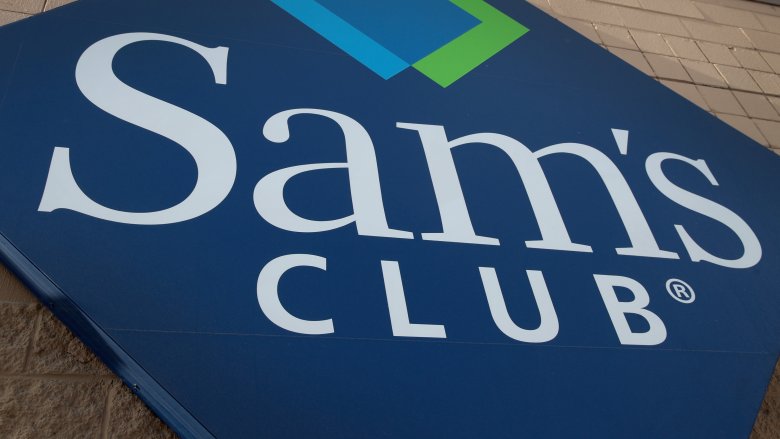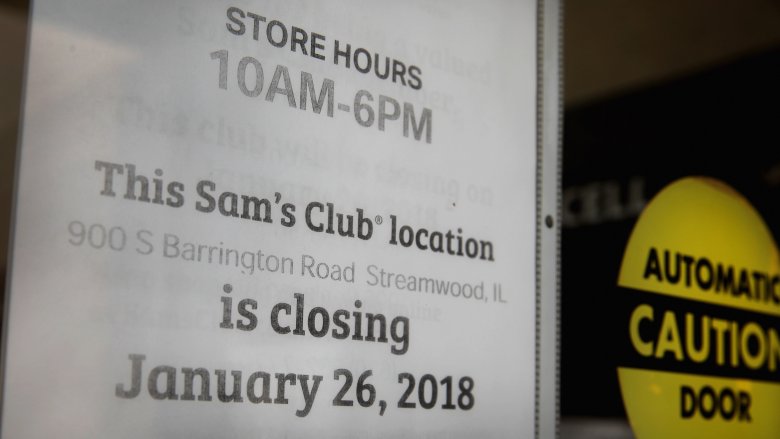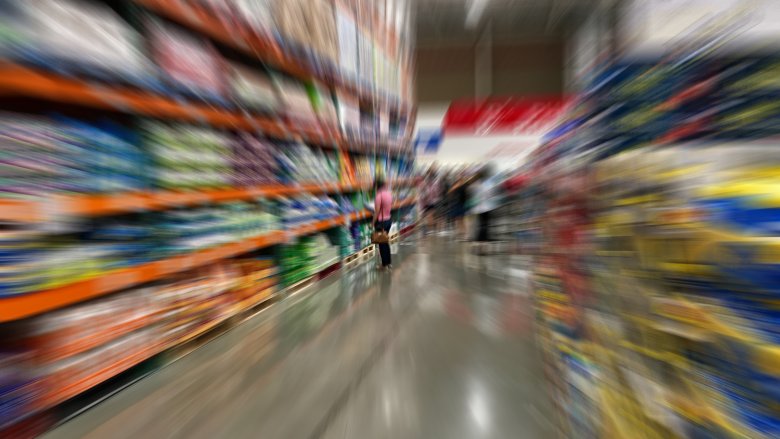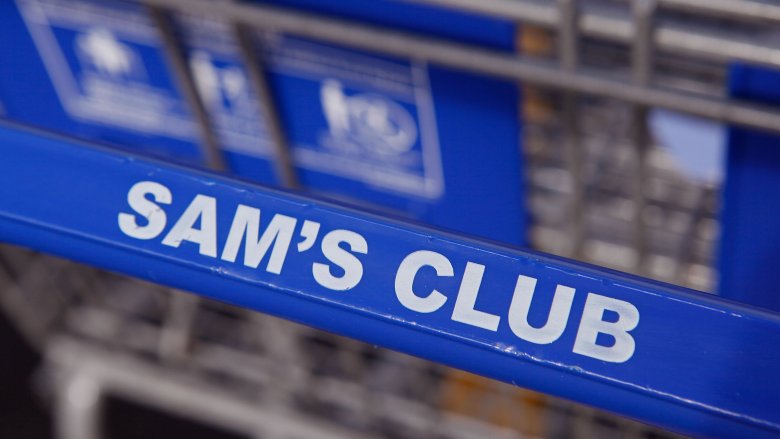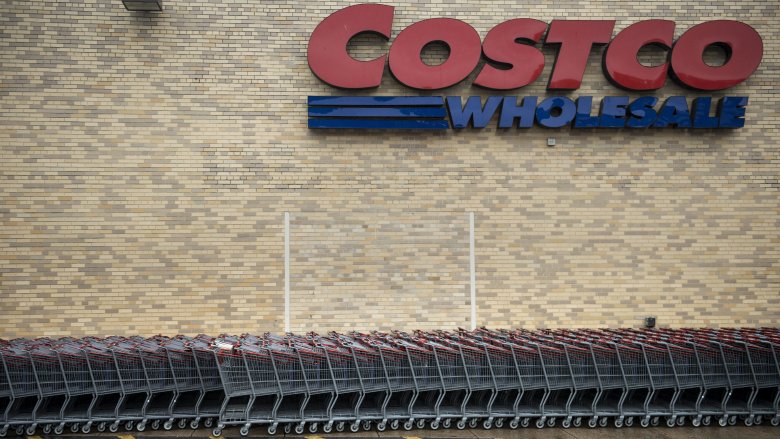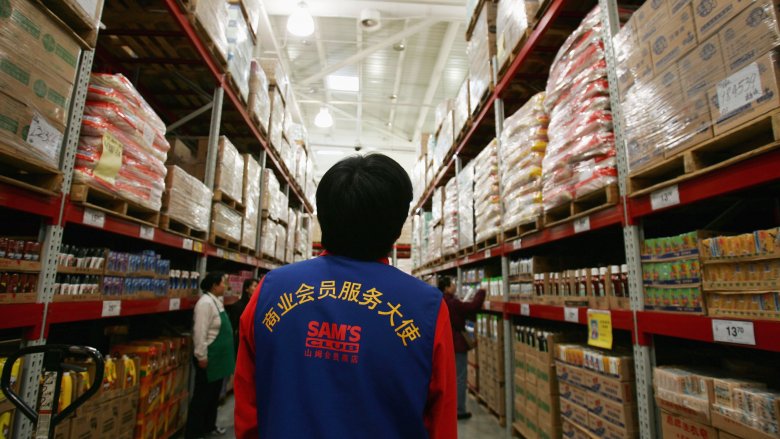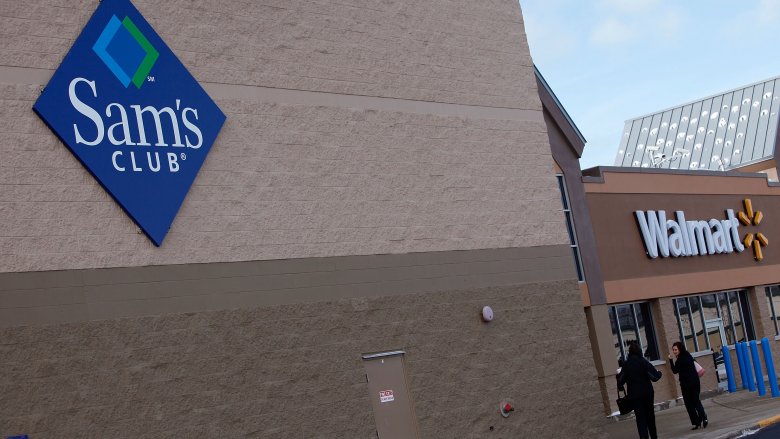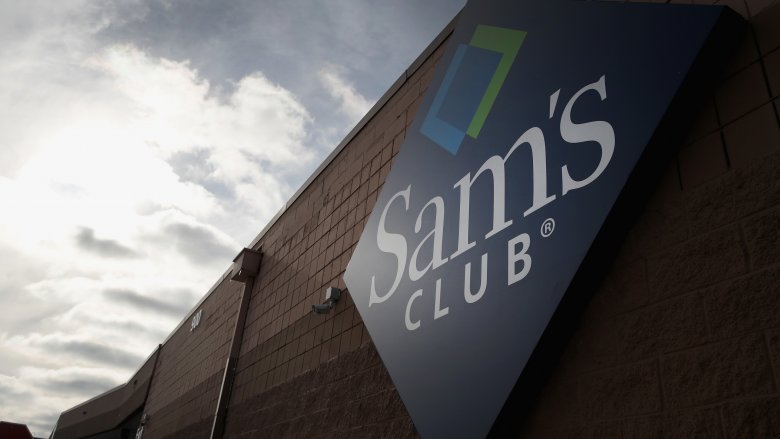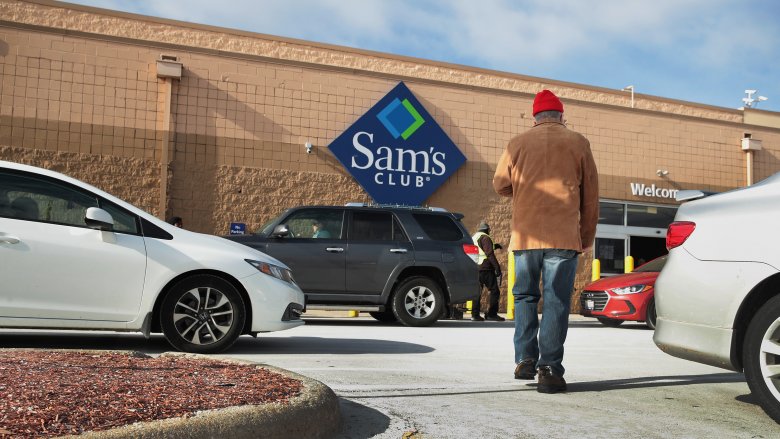The Real Reason Sam's Club Is Disappearing Across The Country
It's easy to forget that both Walmart and Sam's Club started with one man and his five-and-dime store. They've become juggernauts of today's retail landscape, places you can go to get anything and everything for a decent price... even though you might hate what they've done to small businesses.
Somewhat strangely, it was small business owners that Sam Walton wanted to help when he opened Sam's Club in 1983. According to their own history, they started by offering limited products with a narrow focus, designed to be a one-stop shop for business owners. Their model has expanded a bit since then, but they're still a no-frills warehouse that's become as handy for families as for businesses. After all, who doesn't love a place where you can go and stock up on a year's worth of toilet paper and pickles in the same trip?
But in spite of Walmart's domination of America's retail world, Sam's Clubs have been closing across the country. There are some strange reasons behind the business move, too, so let's talk about what's really going on here.
The details of the closings
Sam's Club has been in trouble for a while, with failing sales going back to at least 2015. According to The Motley Fool, they've been trying to improve same-store sales (essentially, the revenue generated by existing stores) for a long time, and they haven't been just flat, they've been going down.
That's why the industry didn't find it was a complete surprise when, in January 2018, some Sam's Club stores across the country didn't open for the day — or ever again. But what was surprising is the complete lack of information passed on from Sam's Club corporate. According to Business Insider, their list of closed stores came from employees who were suddenly out of a job and local media, not from corporate officials. No one knew what was going on, how many were to close, what was to become of them, and how many people were out of a job. The whole thing was even shadier because it was coupled with a feel-good story on how Walmart was going to be expanding their benefits programs and raising their minimum wage. What gives?
They're focusing on the wrong income bracket
Part of Sam's Club's financial problems stem from a bigger problem — the country's economy. According to The Motley Fool, most Sam's Club customers come from middle- and lower-income brackets. When the economy goes bad, they're the ones that feel it and they're the ones cutting back on spending the most. That means they're not heading out to spend a few hundred bucks at Sam's Club. To make matters worse, only about 15 percent of Sam's Club stores are located in the country's most affluent states — compare that to Costco's 41 percent, and you can see why there's a problem.
By the end of January 2018, 63 Sam's Club stores had closed, and The Wall Street Journal was able to see a very distinct pattern. The closures were under-performing stores, but it was also done in such a way that remaining stores could be revamped to target a new group: families with an income of between $75,000 and $125,000. Incoming Sam's Club CEO John Furner noted that the goal was to "transform the business," and added they needed to focus on locations more accessible to the more resilient, higher-income brackets they were going to be targeting.
Small businesses let them down
Sam's Club was originally founded to target small business owners, and yes, that's the same small businesses Walmart has damaged so badly. In a weird twist of cosmic karma, the purchasing habits of those same small business owners have ultimately put a hurt on Sam's.
The Motley Fool says as of 2015, about a third of Sam's Club memberships were held by small business owners. That's a huge percentage, and with that group not spending the amount of money Sam's had expected, that created a cash flow problem for the warehouse giant.
When Sam's hired a consulting firm to tell them where the real problems were, this one was twofold. Not only were small business owners not buying as much as Sam's thought they would, but when they did buy, they were buying mostly products for their home and personal use. That completely skewed their targets, their numbers, and their bottom line.
They're opening a revamped grocery
Another piece of the puzzle fell into place in June 2018, when Business Insider reported Sam's Club would be opening a completely different kind of store: a grocery store. They reported on a yet-unnamed store in Dallas that was a template for the new model, stocked with already prepared meals and fresh food. Many services would tech-centered, including scan-and-go checkouts, self-service returns. It will also be open to members only. At the time of their reporting, it wasn't clear exactly what this was going to mean for the future of Sam's. According to SamsClub.com CEO Jamie Iannone, they were also testing things like same-day pickup and delivery options.
The concept store is much, much smaller than a traditional Sam's Club, with only about a quarter of the footprint. They'll also be carrying a fraction of the items (between 1,000 and 2,000, compared to Sam's usual 6,000), and if all goes according to plan, you might see these tech-savvy grocery stores popping up alongside — or in place of — your neighborhood Sam's.
Costco is a thorn in their side
Competition has been a huge problem for Sam's Club, too, and that mostly comes from Costco. To put things in perspective, The Wall Street Journal looked at the numbers from 2017. While Sam's Club saw a sales increase of just .2 percent, Costco clocked a 3.8 percent rise in sales.
Sam's has been trying to take customers from Costco for years, going back to the addition of higher-end jewelry in 2001. But Sam's Club CEO John Furner says their efforts weren't concentrated, and they spent too much time chasing too many things. They tried to cater to high-end customers, small business owners, lower-income families... the whole deal, while Costco was quietly sitting back and stealing customers. In response, Sam's Club cut their losses along with all their stores in Washington state — the home of Costco. Retail analysts found that's not a coincidence, and 52 of the 63 closed Sam's Club locations were ones that had a Costco within 10 miles. By cutting stores in high-competition areas, they can compete elsewhere.
Some are being turned into fulfillment centers
Amazon is now doing to Sam's Club what Sam's Club and Walmart once did to Pop's hardware store and Mom's five-and-dime. In order to stay competitive in the online market, 12 of their Sam's Club stores are being turned into e-commerce fulfillment centers. The goal is to try to compete with Amazon's insanely fast delivery service, and that's no small challenge.
According to Twice, remodeling some strategically places Sam's Club stores into warehouses is just part of it. They're also offering free shipping and no minimum purchase requirements (for Plus members), and revamping their membership tiers, all to try to cater to the online market. The first fulfillment center — located in Memphis, Tennessee — will double as a testing ground as they find their feet, and Forbes says it's a huge decision that's reflective of the industry. An online shopping platform can make or break a business, especially in an era when consumers are extraordinarily demanding.
They're competing with... themselves
Everyone knows Sam's Club is Walmart's sister company, and that's something that has ended up being a massive problem for them.
According to The Motley Fool, Walmart is actually one of Sam's biggest competitors. At the time they announced they were going to be closing about 10 percent of their locations, they had 660 stores in the US. Of those, 200 of them shared a parking lot with Walmart — which, of course, doesn't require customers buy a membership fee.
They also say that since there's a huge amount of merchandise that's on the shelves at both Walmart and Sam's Club, there are a lot of customers that opt to just run into Walmart instead of fussing over Sam's, their lines, and their memberships. That's put them between a rock and a hard place, losing part of their targeted income customers to Walmart, and part to Costco.
They've ignored Costco's marketing successes
Go into any Costco, and you'll find a ton of their own, store-brand Kirkland products. Everyone knows the name, and the Huffington Post argues that Sam's Club seriously missed the boat by not creating the same sort of signature line of products.
There are a few reasons they say this is super important, and part of it is that Kirkland products create brand loyalty. Since you can only get them at Costco, they end up with loyal Costco customers who are unlikely to jump ship for another, similar warehouse store — especially one that hasn't put the effort into their store brand.
The strength of the Kirkland brand gives Costco something else Sam's Club doesn't enjoy: leverage with suppliers. Take coffee, for example. If suppliers don't meet Costco's expectations or price demands, they can simply stock the shelves with their own products. That likely gets them bigger bargaining power and better deals on the back end, and they can increase profits and pass more savings on to the customer. Kirkland is a huge deal Sam's just can't compete with.
They tried to bury the bad news... and it backfired
There's something else going on here, and just how much it will impact Sam's and Walmart remains to be seen, but it's worth talking about.
Sam's Club's handling of their store closures created nothing less than what CNN called "a PR mess." At the same time they officially announced they were raising minimum wage, giving out bonuses, and expanding some of their benefits, some local news outlets were running a very different story. Employees who had no warning whatsoever were showing up to work and finding their Sam's Club closed.
Nothing about that looks good, and while news and rumors started circulating in the morning, it wasn't until afternoon — and after quite of bit of social media pestering — that Sam's Club finally came clean. Media relations experts chimed in, saying it looked like execs were hoping the good news was going to bury the bad, and while that's never been confirmed, it definitely puts a bad situation in an even worse light. What kind of impact that's going to have on their brand and their plans going forward remains to be seen, but PR disasters rarely work out for the best.
What about all those memberships?
The completely unexpected closure of so many Sam's Clubs left a lot of people with a problem: memberships they'd paid for, but could no longer use. There's good news on this front, says Business Insider.
Customers can get a refund, but only by calling (888) 746-7726 and canceling their membership. Members have the option to get a check, a Walmart gift card, or — strangely — a Sam's Club gift card. Anyone who's interested in keeping their membership can also opt to transfer it to another store, but refund offers are only open to customers who have a membership at any of the closed stores.
It's also worth noting that Money Talks says you don't need a membership for a lot of Sam's Club services. Non-members can shop online (but at the cost of an added 10 percent), and if you're just going to the pharmacy, optometrist, or if you're just buying alcohol, you don't need a card. For, you know, the important stuff.
